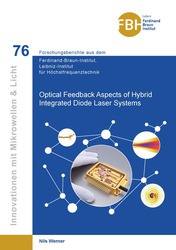| Departments | |
|---|---|
| Book Series (96) |
1378
|
| Nachhaltigkeit |
3
|
| Gesundheitswesen |
1
|
| Humanities |
2364
|
| Natural Sciences |
5406
|
| Mathematics | 229 |
| Informatics | 319 |
| Physics | 980 |
| Chemistry | 1363 |
| Geosciences | 131 |
| Human medicine | 243 |
| Stomatology | 10 |
| Veterinary medicine | 108 |
| Pharmacy | 147 |
| Biology | 835 |
| Biochemistry, molecular biology, gene technology | 121 |
| Biophysics | 25 |
| Domestic and nutritional science | 45 |
| Agricultural science | 1004 |
| Forest science | 201 |
| Horticultural science | 20 |
| Environmental research, ecology and landscape conservation | 148 |
| Engineering |
1793
|
| Common |
98
|
|
Leitlinien Unfallchirurgie
5. Auflage bestellen |
|
Advanced Search
Optical Feedback Aspects of Hybrid Integrated Diode Laser Systems (Volume 76) (English shop)
Nils Werner (Author)Preview
Extract, PDF (1.7 MB)
Table of Contents, PDF (120 KB)
In hybrid integrated diode laser systems diode lasers are combined with components such as optical amplifiers or nonlinear crystals to extend their range of capabilities. However, combining optical components leads to mutual influencing, as each component can be a source of optical feedback which has to be considered in detail. In this work, experimental and theoretical studies are carried out on periodically poled nonlinear crystals (PPNC), semiconductor optical amplifiers (SOA), and distributed Bragg-reflector ridge waveguide lasers (DBR-RWL).
Periodic poling in PPNCs results in grating-like refractive index modulations that cause wavelength-dependent reflection characteristics with typical resonances. The optical feedback from PPNCs is directed to the pump laser source with reflectances from 10-4 to 10-2.
In SOAs, the optical feedback depends on the operating point while spontaneous emission can be a significant source. With respect to the input power, the reflectance is between 10-3 and 10-1. While the reflectance can exceed unity if additional external optical feedback enters the SOA, the optical feedback from the SOA is still defined by the internal structure of the SOA and directed to the input laser source.
The emission behavior of DBR-RWLs subject to strong optical feedback is characterized by thermal effects and spectral mode hops that go beyond usual optical feedback considerations. Even DBR-RWLs insensitive to coherence collapse can be affected for feedback reflectances higher than 10-3.
The investigations in this thesis provide a deeper understanding of the optical feedback characteristics of components in hybrid diode laser systems. This results in starting points for further component improvements and new concepts for the realization of hybrid laser systems.
| ISBN-13 (Hard Copy) | 9783689520052 |
| ISBN-13 (eBook) | 9783689520403 |
| Final Book Format | A5 |
| Language | English |
| Page Number | 184 |
| Lamination of Cover | matt |
| Edition | 1 |
| Book Series | Innovationen mit Mikrowellen und Licht. Forschungsberichte aus dem Ferdinand-Braun-Institut, Leibniz-Institut für Höchstfrequenztechnik |
| Volume | 76 |
| Publication Place | Göttingen |
| Place of Dissertation | TU Berlin |
| Publication Date | 2024-07-24 |
| General Categorization | Dissertation |
| Departments |
Natural Sciences
Electrical engineering |
| Keywords | emission, optical, waveguide, light, Emission, optisch, Wellenleiter, Licht, optical feedback, optische Rückkopplung, tapered amplifiers, konische Verstärker, Astigmatismus, astigmatism, Bragg-Reflektor-Rückenwellenleiterlaser, Bragg-Reflector Ridge Waveguide Laser, Lang-Kobayashi Equations, Lang-Kobayashi-Gleichungen, periodisch gepolte nichtlineare Kristalle, periodically poled non-linear crystals |








